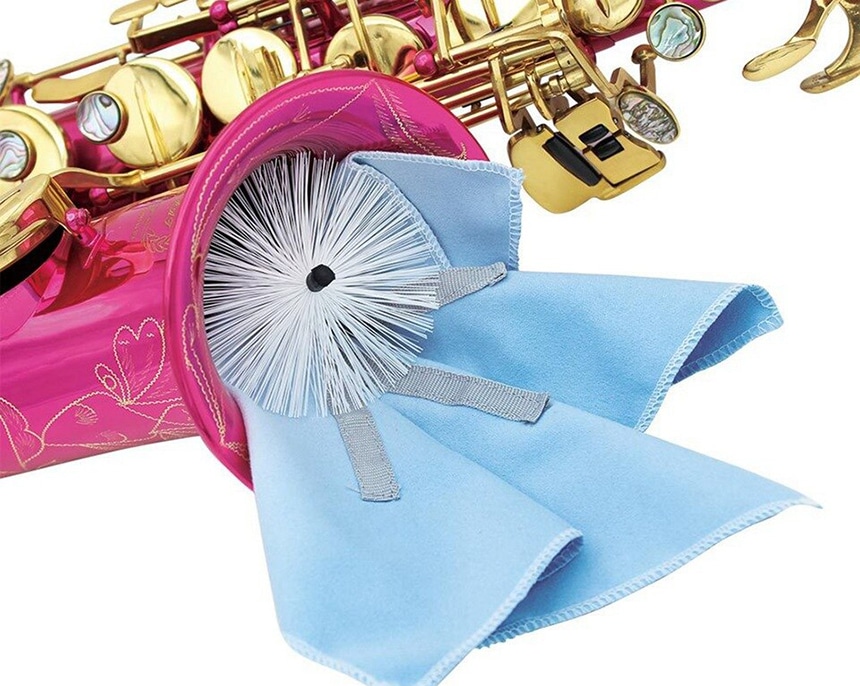The saxophone was invented around 1840 by a man called Adolphe Sax Trusted Source Saxophone - Wikipedia The saxophone is a type of single-reed woodwind instrument with a conical body, usually made of brass. en.wikipedia.org and quickly grew in popularity. Like all woodwind instruments, however, it can quickly become dirty. During play, the moist air from your mouth can collect in the mouthpiece. This moisture can result in damage to the saxophone’s mechanisms and can cause problems in your performance.
This is why maintaining your saxophone is vital, and it’s essential to know how to clean a saxophone properly. Besides saving you money on costly repairs, it will also keep your instrument in the best condition possible.
Cleaning your saxophone will also benefit your health. A condition called “Saxophone Lung” can occur if your instrument is not cleaned out regularly. This is caused by the build-up of black mold inside of the instrument.
It is a good practice to clean your saxophone at the end of each practice session and performance by using a saxophone cleaning kit, which should include all the tools seen in the Luvay Sax Cleaning Kit. Here we take a closer look at how to clean a saxophone.

The first step is to clean the inner part of the saxophone. The wind instrument has an intricate and delicate design. After using your saxophone a few times, dirt, moisture, and bacteria can wear down the saxophone’s metal by getting into the screws, pads, and hinge posts. Here’s how to clean the interior of your saxophone.
This piece comes in contact with your mouth every time you play. After each session, remove your reed and store it in a reed case to prevent any bacteria growth. This will also save your budget as you won’t need to replace it as often. If you are looking for a mouthpiece replacement for the alto saxophone, consider the Vandoren SM711 AL3. Our experts recommend it because of the well-balanced sound it delivers.
It is an excellent idea to clean your saxophone mouthpiece regularly. A thorough wash once a week is a good idea if you’re a regular player. The first step is to remove the reed of your mouthpiece. Use a mouthpiece brush to clean out any build-up of dirt and particles from the inside.
Use warm soapy water to rinse the mouthpiece and dry it off with a lint-free cloth in case there are any particles left behind. For extra care, soak your mouthpiece in vinegar or a malt detergent with water.
Once the mouthpiece is clean, you now need to clean the reed. The saxophone reed is an important part to clean as it’s a hotspot for bacteria growth. After using your saxophone, thoroughly wipe down the reed with a cotton swab or clean towel to eliminate fungal growth. You could also soak your reed in mouthwash or alcohol to eliminate bacteria. Make sure your reed is dry before you use it again.

Clean the body of the saxophone by swabbing it. This helps to dry the inside to prevent the build-up of dirt and bacteria, as well as protecting the pads. It is common for a light green color to appear on the cloth once you have swabbed it several times.
When using a swab, you’ll have a cloth or brush on a string that has a weight attached to the other end. The weight should be placed inside the bell of the saxophone, and you then turn the saxophone on its head. Gently pull the weighted end until it comes out of the smaller end. Repeat this motion a few times.
Next, you are going to swab the neck. You are going to repeat the same process as above by placing a flexible cloth in the neck at the larger base opening. Pull the swab through to the narrow side where the cork is placed. Swab the neck until all dirt and moisture are removed.
Sticky keys can be quite common among saxophone players. You can prevent this by brushing the teeth before and after playing. Inspect your saxophone for any sticky pads when you are playing. Also, look under the pads for any signs of wear and tear. Use a thin piece of paper or wet cotton swabs to clean between the pads and the tone. Repeat this process several times until it’s completely clean and dry. Use clean water to remove any other sticky residue.
Use a brass lacquer polishing cloth to polish the outer body of the saxophone once you are done cleaning the interior.
Detect any loose screws that may be on your instrument. Tighten them but without extra power. Put your saxophone back together carefully and pack away your saxophone cleaning kit. Use a small amount of soap to clean swabs, cloths, and brushes.
If there is still a large amount of dirt and constant sticking keys after you’ve gone through the cleaning process, you might need to take your saxophone into a repair shop. A professional will take a look at your saxophone and make sure it is in proper working condition. This can include taking apart the sax, which requires expert knowledge and skill.
Many musicians tend to neglect cleaning and maintaining the instruments until they do not sound or feel the way they would like them to. This results in spending large amounts of money to repair and sometimes even to purchase a new one.
While we put a lot of focus on scratches and dents, it’s the inside of the saxophone we should be most worried about. Cleaning your saxophone does not have to be a long and challenging process. The simple cleaning steps mentioned above will ensure that your saxophone stays in good condition over a long period of time.
Take care of your instrument, and you will be able to use it for many years to come. Hopefully, now you know exactly how to clean a saxophone.